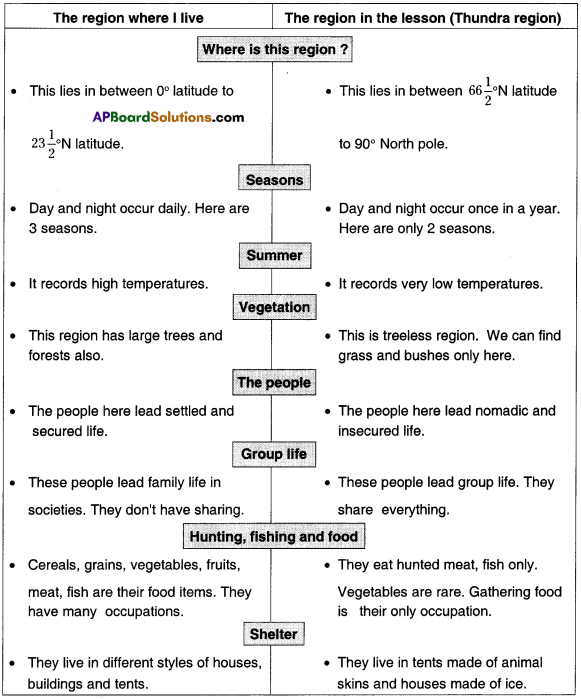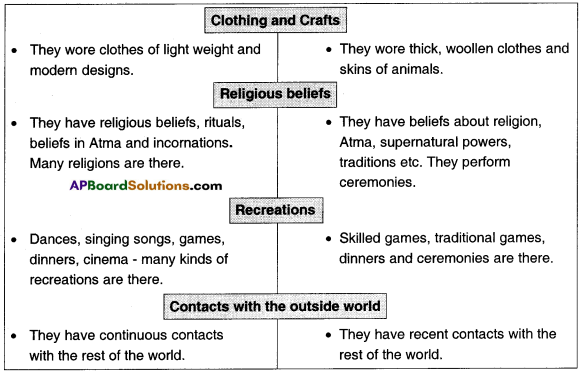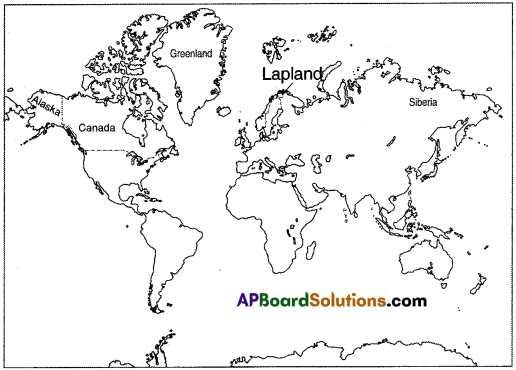 |
| AP Board Class 8 Social Studies Chapter 4 The Polar Regions Textbook Solutions PDF: Download Andhra Pradesh Board STD 8th Social Studies Chapter 4 The Polar Regions Book Answers |
Andhra Pradesh Board Class 8th Social Studies Chapter 4 The Polar Regions Textbooks Solutions PDF
Andhra Pradesh State Board STD 8th Social Studies Chapter 4 The Polar Regions Books Solutions with Answers are prepared and published by the Andhra Pradesh Board Publishers. It is an autonomous organization to advise and assist qualitative improvements in school education. If you are in search of AP Board Class 8th Social Studies Chapter 4 The Polar Regions Books Answers Solutions, then you are in the right place. Here is a complete hub of Andhra Pradesh State Board Class 8th Social Studies Chapter 4 The Polar Regions solutions that are available here for free PDF downloads to help students for their adequate preparation. You can find all the subjects of Andhra Pradesh Board STD 8th Social Studies Chapter 4 The Polar Regions Textbooks. These Andhra Pradesh State Board Class 8th Social Studies Chapter 4 The Polar Regions Textbooks Solutions English PDF will be helpful for effective education, and a maximum number of questions in exams are chosen from Andhra Pradesh Board.Andhra Pradesh State Board Class 8th Social Studies Chapter 4 The Polar Regions Books Solutions
| Board | AP Board |
| Materials | Textbook Solutions/Guide |
| Format | DOC/PDF |
| Class | 8th |
| Subject | Maths |
| Chapters | Social Studies Chapter 4 The Polar Regions |
| Provider | Hsslive |
How to download Andhra Pradesh Board Class 8th Social Studies Chapter 4 The Polar Regions Textbook Solutions Answers PDF Online?
- Visit our website - Hsslive
- Click on the Andhra Pradesh Board Class 8th Social Studies Chapter 4 The Polar Regions Answers.
- Look for your Andhra Pradesh Board STD 8th Social Studies Chapter 4 The Polar Regions Textbooks PDF.
- Now download or read the Andhra Pradesh Board Class 8th Social Studies Chapter 4 The Polar Regions Textbook Solutions for PDF Free.
AP Board Class 8th Social Studies Chapter 4 The Polar Regions Textbooks Solutions with Answer PDF Download
Find below the list of all AP Board Class 8th Social Studies Chapter 4 The Polar Regions Textbook Solutions for PDF’s for you to download and prepare for the upcoming exams:8th Class Social Studies 4th Lesson The Polar Regions Textbook Questions and Answers
Improve your learning
Question 1.
Re-write the false statements with correct facts:
a) Animal body parts were used only in clothing.
Answer:
True: Animal body parts were used in food, construction of houses, clothes, and in making weapons.
b) Major part of the food includes vegetables.
Answer:
True: Major part of the food includes animal meat and fish.
c) Popular games amongst the people in Tundra are closely related to their daily lives.
Answer:
True
d) Contact with people from outside impacted their health.
Answer:
True
Question 2.
Based on what you studied about equator regions in Class VII, how is polar region different?
Answer:
| Equator region | Polar region |
| 1. This extends from 0° to 2312° North and South latitudes. | 1. This extends from 6612° N latitude to 90°N. |
| 2. The Sun’s rays fall straight on this region. | 2. The Sun’s rays fall slantingly on this region. |
| 3. This region has 3 main seasons. | 3. This region has 2 main seasons. |
| 4. Formation of day and night occurs in one day. | 4. Formation of day and night occurs in one year. |
| 5. The people of this region lead settled life. | 5. The people of this region lead nomadic life. |
| 6. They have contacts with rest of the world. | 6. They have less contacts with rest of the world. |
Question 3.
What are the ways in which life of people in Tundra are dependent on climate of the region? Describe in the context of following aspects:
| Food | Dress | Travel | Shelter |
Answer:
Climate influences the people of the Tundra.
| Food | Dress | Travel | Shelter |
| Cereals and grains are not cultivated here due to frozen ice. They should lead their life with meat and fish. They cannot even cook the food. So they should eat raw meat. They store the food in the frozen ice. | These people wear skins of animals and their fur. They should wear clothes from top of the head to bottom of the feet. They wear two piece dresses and and designed. | They need vehicles which are wide in shape to travel in ice. So they travel on platform like vehicles called sledges. These are drawn by polar dogs. They use kayaks and umiyaks to travel in waters in summers. | The land is covered with a layer of snow. Laying foundation is not possible. So they live in wooden tents covered with animal skins. And also they construct houses of ice blocks. They use ice blocks to sleep as cots. |
Question 4.
In this chapter there are many aspects that are very different from the place where you live. Look at the subheadings in this chapter and make a list of them. Now create a wall paper with illustrations and descriptions comparing life in your location with that in the Tundra.
Answer:
The comparison between the life of the people of N. polar region and that of the people of the equatorial region

Question 5.
Imagine one entire day (24 hours) when the Sun does not set and another day when there is no Sun. What changes will you make in your daily lives ? Write a short note on them.
Answer:
When the Sun does not set: We should shut all the doors and windows of our house and make it dark to sleep. Rest of the day will be okay.
When there is no Sun: We should arrange lights probably flood lights to get light everywhere. Then we should perform our daily works.
This is possible for only one day.
Question 6.
Find out the five living places of Eskimos in the world map
Answer:
Greenland, Alaska, Canada, Siberia, Lapland are the five places shown in the below map.
8th Class Social Studies 4th Lesson The Polar Regions InText Questions and Answers
Question 1.
Which continent parts fall within this region? (Textbook Page No. 40)
Answer:
North America, Europe and some parts of Russia fall within this region.
Question 2.
Try to recall what happens as we move away from the equator. (Textbook Page No. 40)
Answer:
Temperature falls when we move from the equator to the poles.
Question 3.
Mention five points about the summer in Tundra. (Textbook Page No. 42)
Answer:
- The Sun begins to shine in the tundra around February-March. In the beginning the Sunsets within a short time.
- For almost three months from May to July, the Sun never sets.
- The Sun does not rise overhead. It just hovers a little above the horizon. So it is never very warm.
- Due to the relatively warm weather, some of the ice melts. The rivers, lakes melt and begin to flow.
- When summer approaches, many multi-coloured plants, lichens, grass, shrubs and berries sprout around.
Question 4.
Fill in the blanks : (Textbook Page No. 42)
1. The Sun does not appear during the month of November, December and January.
2. At this time, the water freezes and the plants cover with the snow.
Question 5.
How do the people of Tundra get light in winter ? (Textbook Page No. 42)
Answer:
There will be no sunlight during the winter in the polar region. At this time, the light of stars
falls on the ice, reflects, and fills the region with bright colourful lights. These are known as ‘Aurora Borialisis’. During winter they get light with these Aurora borialisis, oil and fat lamps.
In what ways are the resources available in their surroundings used for making houses? (Textbook Page No. 45)
- They use skins of animals and wood for tents.
- They use logs and whale ribs in building round houses.
- They form ice blocks (like bricks) and build domed houses.
Thus they use available resources in the surroundings.
Question 6.
Did you see any tree in the pictures on the previous page? (Textbook Page No. 42)
Answer:
No. Grass and small bushes are visible in the pictures given.
Question 7.
Look at the pictures in this chapter (The Polar Region). How has that dress and hunting changed? (Textbook Page No. 48)
Answer:
The people of the earlier times wore raw skins of animals. They are too heavy. They use the horns of animals, harpoons, sharp edged instruments to hunt.
In the modern times they wore designed caps, dresses which are light in weight. Guns occupied the place of traditional weapons.
Question 8.
Why do you think people probably always did not live in the Tundra region? (Textbook Page No. 43)
Answer:
There are no seasons or seasonal differences in tundras. They have likely temperatures and seasons. They face nominal summers. So they cannot cultivate crops here. They have no tasty foods and different kinds of foods. During winters the whole region becomes dark, deserted and desolate. So they did not live here throughout the year.
Question 9.
How is the house impacted by the climate? (Textbook Page No. 45)
Answer:
Their houses are called igloos. In summer, most Eskimos live in tents made of animal skins. In some areas, they made tents of wood and animal skins. They use logs and whale ribs also for this. They use stone slabs in some areas. Snow houses are made from blocks of packed snow, built into a dome. They build snow platforms for their sleep. As the area is covered with snow they cannot lay foundations and they cannot lead a settled life. Thus the house is impacted by the climate.
Question 10.
Do you think lives of people in Tundra have changed for better or worsened because of their interaction with outside world? Give reasons for your answer. (Textbook Page No. 48)
Answer:
The lives of people in Tundra have changed for better or worst both because of their interaction with the outside world.
The pattern of relations between the Eskimos and outsiders has been described as “boom and bust”. Waves of outsiders have brought brief periods of wealth, education, and employment. This was followed by periods of poverty and disorganisation. Peak periods have been those of whaling (1859 to 1910), the modern fur trade (1925 to about 1950), the building of military and defence bases (the mid-1950s), the building of urban centres (mid- 1960s), and oil exploration and development (the 1970s).
Each wave of activity has drawn the Eskimos into contact with different social and economic forces. The once isolated northlands have been opened up by air travel, highways, powerful modern ships, and satellite communications. These changes have produced great strains on the Eskimo way of life.
AP Board Textbook Solutions PDF for Class 8th Social Studies
- AP Board Class 8 Textbook Solutions PDF
- AP Board Class 8 Social Studies Textbook Solutions PDF
- AP Board Class 8 Social Studies Chapter 1 Reading and Analysis of Maps Textbook Solutions PDF
- AP Board Class 8 Social Studies Chapter 2 Energy from the Sun Textbook Solutions PDF
- AP Board Class 8 Social Studies Chapter 3 Earth Movements and Seasons Textbook Solutions PDF
- AP Board Class 8 Social Studies Chapter 4 The Polar Regions Textbook Solutions PDF
- AP Board Class 8 Social Studies Chapter 5 Forests Using and Protecting Them Textbook Solutions PDF
- AP Board Class 8 Social Studies Chapter 6 Minerals and Mining Textbook Solutions PDF
- AP Board Class 8 Social Studies Chapter 7 Money and Banking Textbook Solutions PDF
- AP Board Class 8 Social Studies Chapter 8 Impact of Technology on Livelihoods Textbook Solutions PDF
- AP Board Class 8 Social Studies Chapter 9 Public Health and the Government Textbook Solutions PDF
- AP Board Class 8 Social Studies Chapter 10 Landlords and Tenants under the British and the Nizam Textbook Solutions PDF
- AP Board Class 8 Social Studies Chapter 11A National Movement The Early Phase 1885-1919 Textbook Solutions PDF
- AP Board Class 8 Social Studies Chapter 11B National Movement The Last Phase 1919-1947 Textbook Solutions PDF
- AP Board Class 8 Social Studies Chapter 12 Freedom Movement in Hyderabad State Textbook Solutions PDF
- AP Board Class 8 Social Studies Chapter 13 The Indian Constitution Textbook Solutions PDF
- AP Board Class 8 Social Studies Chapter 14 Parliament and Central Government Textbook Solutions PDF
- AP Board Class 8 Social Studies Chapter 15 Law and Justice A Case Study Textbook Solutions PDF
- AP Board Class 8 Social Studies Chapter 16 Abolition of Zamindari System Textbook Solutions PDF
- AP Board Class 8 Social Studies Chapter 17 Understanding Poverty Textbook Solutions PDF
- AP Board Class 8 Social Studies Chapter 18 Rights Approach to Development Textbook Solutions PDF
- AP Board Class 8 Social Studies Chapter 19 Social and Religious Reform Movements Textbook Solutions PDF
- AP Board Class 8 Social Studies Chapter 20 Understanding Secularism Textbook Solutions PDF
- AP Board Class 8 Social Studies Chapter 21 Performing Arts and Artistes in Modern Times Textbook Solutions PDF
- AP Board Class 8 Social Studies Chapter 22 Film and Print Media Textbook Solutions PDF
- AP Board Class 8 Social Studies Chapter 23 Sports Nationalism and Commerce Textbook Solutions PDF
- AP Board Class 8 Social Studies Chapter 24 Disaster Management Textbook Solutions PDF
- AP Board Class 8 Social Studies Chapter 1 పటాల అధ్యయనం – విశ్లేషణ Textbook Solutions PDF
- AP Board Class 8 Social Studies Chapter 2 సూర్యుడు – శక్తి వనరు Textbook Solutions PDF
- AP Board Class 8 Social Studies Chapter 3 భూ చలనాలు – రుతువులు Textbook Solutions PDF
- AP Board Class 8 Social Studies Chapter 4 ధృవ ప్రాంతాలు Textbook Solutions PDF
- AP Board Class 8 Social Studies Chapter 5 అడవులు – వినియోగం, సంరక్షణ Textbook Solutions PDF
- AP Board Class 8 Social Studies Chapter 6 ఖనిజాలు, గనుల తవ్వకం Textbook Solutions PDF
- AP Board Class 8 Social Studies Chapter 7 ద్రవ్యం, బ్యాంకింగ్ Textbook Solutions PDF
- AP Board Class 8 Social Studies Chapter 8 జీవనోపాధులు – సాంకేతిక విజ్ఞాన ప్రభావం Textbook Solutions PDF
- AP Board Class 8 Social Studies Chapter 9 ప్రజారోగ్యం – ప్రభుత్వం Textbook Solutions PDF
- AP Board Class 8 Social Studies Chapter 10 బ్రిటిష్, నిజాంల పాలనలో భూస్వాములు, కౌలుదార్లు Textbook Solutions PDF
- AP Board Class 8 Social Studies Chapter 11A జాతీయోద్యమం : తొలి దశ 1885 – 1919 Textbook Solutions PDF
- AP Board Class 8 Social Studies Chapter 11B జాతీయోద్యమం : మలి దశ 1919 – 1947 Textbook Solutions PDF
- AP Board Class 8 Social Studies Chapter 12 భారత ఎన్నికల వ్యవస్థ Textbook Solutions PDF
- AP Board Class 8 Social Studies Chapter 13 భారత రాజ్యాంగం Textbook Solutions PDF
- AP Board Class 8 Social Studies Chapter 14 పార్లమెంటు – కేంద్ర ప్రభుత్వం Textbook Solutions PDF
- AP Board Class 8 Social Studies Chapter 15 చట్టం, న్యాయం – ఒక సన్నివేశ అధ్యయనం Textbook Solutions PDF
- AP Board Class 8 Social Studies Chapter 16 జమీందారీ వ్యవస్థ రద్దు Textbook Solutions PDF
- AP Board Class 8 Social Studies Chapter 17 పేదరికం – అవగాహన Textbook Solutions PDF
- AP Board Class 8 Social Studies Chapter 18 హక్కులు – అభివృద్ధి Textbook Solutions PDF
- AP Board Class 8 Social Studies Chapter 19 సాంఘిక, మత సంస్కరణోద్యమాలు Textbook Solutions PDF
- AP Board Class 8 Social Studies Chapter 20 లౌకికత్వం – అవగాహన Textbook Solutions PDF
- AP Board Class 8 Social Studies Chapter 21 ఆధునిక కాలంలో కళలు – కళాకారులు Textbook Solutions PDF
- AP Board Class 8 Social Studies Chapter 22 సినిమా – ముద్రణా మాధ్యమాలు Textbook Solutions PDF
- AP Board Class 8 Social Studies Chapter 23 క్రీడలు : జాతీయత, వాణిజ్యం Textbook Solutions PDF
- AP Board Class 8 Social Studies Chapter 24 విపత్తులు – నిర్వహణ Textbook Solutions PDF






0 Comments:
Post a Comment